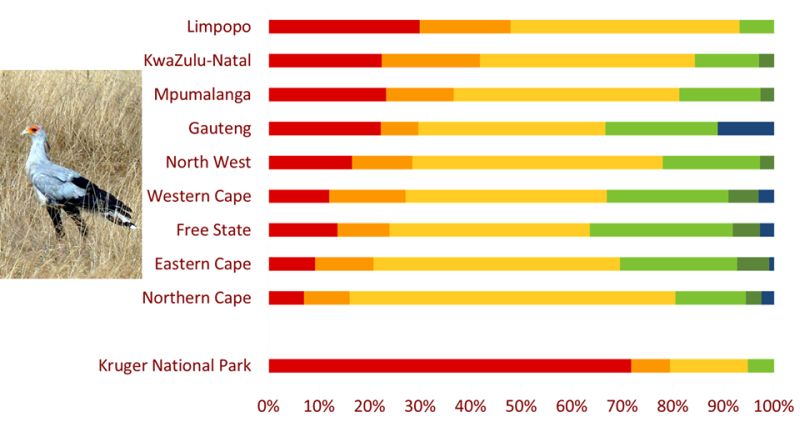Secretarybird Sagittarius serpentarius Population Trends and Ecology: Insights from South African Citizen Science Data
Abstract
Data from two long-term citizen science projects were used to examine the status and ecology of a Red List species, the Secretarybird Sagittarius serpentarius (Vulnerable), in South Africa. The first phase of the Southern African Bird Atlas Project operated from 1987 until 1992, and the second phase began in 2007. The Coordinated Avifaunal Roadcounts (CAR) project began in 1993 and by 1998 had expanded to cover much of the south-eastern half of the country. Data submitted up until April 2013 were used. A new method of comparing reporting rates between atlas projects was developed. Changing reporting rates are likely to reflect changes in abundance; in this instance the data suggest that the Secretarybird population decreased across much of South Africa between the two atlas projects, with a widespread important decrease in the Kruger National Park. Habitat data from the CAR project were analysed to gain insight into the ecology of the species. Secretarybirds tended to avoid transformed habitats across much of the area covered by the CAR project. In the winter rainfall region of the Western Cape, which is characterised by heavily transformed fynbos vegetation, at least 50% of Secretarybirds recorded were in transformed environments. This implies that in the Fynbos biome, at least, Secretarybirds have adapted to transformed environments to some degree. However, in the rest of the country it is likely that habitat loss, largely through widespread bush encroachment but also through agriculture, afforestation, and urbanisation, is a major threat to the species. The methods developed here represent a new approach to analysing data from long-term citizen science projects, which can provide important insights into a species' conservation status and ecology.
Download full article here
Threats to Secretarybirds & Secretarybird Conservation
- nan
- Posts: 26445
- Joined: Thu May 31, 2012 9:41 pm
- Country: Switzerland
- Location: Central Europe
- Contact:
Re: Secretarybird population in decline
what a shame... soon all will decline... except the destructors 
Kgalagadi lover… for ever
https://safrounet.piwigo.com/
https://safrounet.piwigo.com/
- Mel
- Global Moderator
- Posts: 26737
- Joined: Sat May 19, 2012 12:31 pm
- Country: Germany
- Location: Föhr
- Contact:
Re: Secretarybird population in decline
Oh no! 
Very wise words, nan...
Very wise words, nan...
God put me on earth to accomplish a certain amount of things. Right now I'm so far behind that I'll never die.
Re: Secretarybird population in decline
Here an interesting comment from Animal Demography Unit FB: Bush encroachment obviously a major cause 
Sadly, the Secretarybird is marching out of the picture. The graphic has a line for each province. The RED part of the line indicates the percentage of grid cells in the province where the reporting rate for Secretarybirds has decreased so much that it gets the statisticians jumping up and down. The ORANGE is the percentage that show significant decreases. The YELLOW is the percentage where the change is a decrease, but it is not significant, and LIGHT GREEN is the percentage where the change is an non-significant increase; grid cells are often in these categories because the sample sizes of checklists are quite small. DARK GREEN and BLUE represent significant increases, but these form a tiny fraction of the lines.
In all provinces, RED, ORANGE and YELLOW predominate. Secretarybirds are walking out of the picture. Over the northeastern provinces, there is lots of RED and ORANGE, pointing to statistically significant decreases.
But the hugely alarming line is the one at the bottom, for the Kruger National Park. 72% of the grid cells here have "jump-up-and-down" decreases. The usual culprits, such as land transformation, afforestation, poisoning, powerline collisions, etc, etc, cannot be blamed. It seems certain that the biggest factor leading to the decrease in Secretarybirds, not just in the Kruger National Park, but also in the northeastern provinces, is bush encroachment and bush thickening. Secretarybirds need big open tracts of grassland, and as they become bushy, the birds move out. We now understand the primary reason for the decline; the solution is not so easy.

-
Duke
Re: Secretarybird population in decline
Thanks Toko. Was shocked to see the KNP figures. Like the article says, not an easy solution.
- Lisbeth
- Site Admin
- Posts: 65510
- Joined: Sat May 19, 2012 12:31 pm
- Country: Switzerland
- Location: Lugano
- Contact:
Re: Secretarybird population in decline
Not at all nice  It is such a special bird
It is such a special bird 
"Education is the most powerful weapon which you can use to change the world." Nelson Mandela
The desire for equality must never exceed the demands of knowledge
The desire for equality must never exceed the demands of knowledge
-
Klipspringer
- Global Moderator
- Posts: 5858
- Joined: Sat Sep 14, 2013 12:34 pm
- Country: Germany
- Contact:
- Richprins
- Committee Member
- Posts: 75014
- Joined: Sat May 19, 2012 3:52 pm
- Location: NELSPRUIT
- Contact:
Re: Threats to Secretarybirds & Secretarybird Conservation
Please check Needs Attention pre-booking: https://africawild-forum.com/viewtopic.php?f=322&t=596


